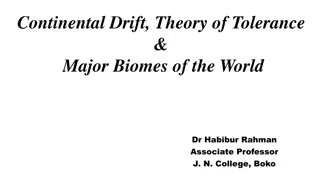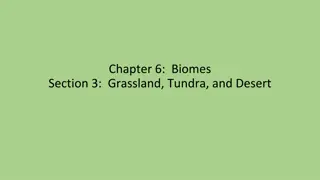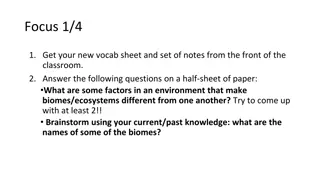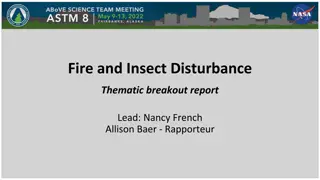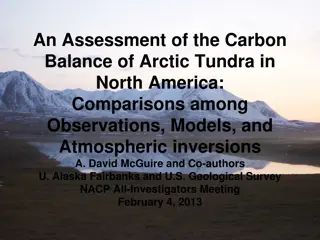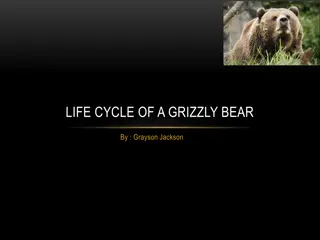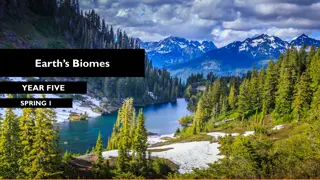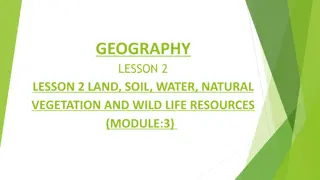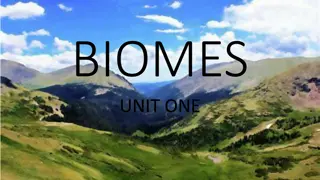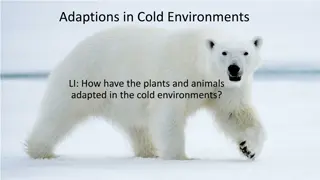Understanding Ecosystems: Types, Components, and Interactions
Different types of ecosystems, their components, and how they interact with each other. Explore natural ecosystems, such as deserts and rainforests, as well as artificial ecosystems. Discover the importance of terrestrial, aquatic, forest, marine, freshwater, tundra, and grassland ecosystems.
4 views • 6 slides
Exploring the Tundra and Taiga Biomes
Discover the unique characteristics of the tundra and taiga biomes, from the frozen landscapes of the tundra with its array of adapted plant and animal species to the coniferous forests of the taiga teeming with diverse wildlife. Learn about the extreme climate conditions and fascinating ecosystems
0 views • 28 slides
Continental Drift, Theory of Tolerance & Major Biomes of the World Overview
This detailed presentation explores topics like Continental Drift, the Theory of Tolerance, and Major Biomes of the World. It covers the history of the Continental Drift theory, from Wegener to Du Toit's modifications, and delves into the various terrestrial biomes that exist, including tundra, bore
2 views • 26 slides
Grassland, Tundra, and Desert Biomes: Exploring Earth's Diverse Landscapes
Grassland, tundra, and desert biomes are unique ecosystems shaped by varying levels of rainfall. From the grassy plains of savannas to the harsh conditions of tundras, each biome hosts a diverse array of plants and animals adapted to survive in challenging environments. Discover the distinct charact
0 views • 28 slides
Understanding Biomes: Climate, Vegetation, and Adaptations
Biomes are vast regions defined by climate, plant and animal communities. Factors like climate, geography, and vegetation impact the unique characteristics of each biome. Understanding biomes involves knowledge of climate, geography, vegetation adaptations, and animal diversity. Changes in one part
0 views • 23 slides
Boreal Wildfire Effects and Research Synthesis
The thematic breakout report focuses on the impacts of fire and insect disturbances on the environment, with projects studying wildfires in boreal regions and their effects on ecosystems. Various studies funded by agencies like NASA and ERC aim to understand wildfire vulnerability, resiliency, and c
0 views • 10 slides
Exploring the Fascinating Tundra Biome: A Comprehensive Guide
Delve into the unique ecosystem of the tundra biome near the Arctic Circle, characterized by extreme cold, limited plant life, and diverse animal adaptations. Discover the beauty of this harsh yet resilient environment, where animals like polar bears and penguins thrive amidst challenging conditions
2 views • 11 slides
Carbon Balance of Arctic Tundra in North America: An Overview
This assessment delves into the carbon balance of Arctic tundra in North America, comparing observations, models, and atmospheric inversions. Co-authored by researchers from various institutions, the study analyzes data from 1960 onwards, addressing the changing CO2 sink in high latitudes. It evalua
0 views • 17 slides
Exploring the Life Cycle and Habitat of a Grizzly Bear
Delve into the fascinating life cycle and habitat of grizzly bears, from their varied habitats encompassing grasslands, tundra, and more, to their adaptations, diet, and behavior such as eating berries, roots, fish, and even deer. Discover how grizzly bear cubs differ from adults and the aggressive
0 views • 8 slides
Understanding Biomes: Concept, Classification, and Factors
Biomes are large natural ecosystems encompassing plant and animal communities shaped by shared physical climates. They are classified based on climate, vegetation, soil-water, and heat availability, encompassing diverse environments like deserts, forests, savannas, and oceans. The concept of biomes
0 views • 6 slides
Exploring Earth's Biomes in Year 5 Spring
Delve into the fascinating world of Earth's biomes through an engaging learning review in Year 5 Spring. Discover diverse ecosystems like tundra, desert, temperate broadleaf forest, tropical forest, grasslands (Savannah), and coniferous forest (Taiga). Enhance your knowledge of different climates, p
0 views • 11 slides
Understanding Natural Vegetation and Wildlife Resources
Natural vegetation and wildlife play a crucial role in the biosphere, providing essential resources and maintaining ecological balance. The interaction between the lithosphere, hydrosphere, and atmosphere creates the biosphere where living organisms thrive. Plants offer timber, oxygen, and other val
0 views • 16 slides
Understanding Biomes and Ecosystems in Nature
Exploring the concept of biomes and ecosystems, the interaction between living and nonliving elements in nature, the adaptation of species to their habitats, and the different types of biomes like tundra, forests, grasslands, deserts, and aquatic biomes. The extreme conditions of tundra and deserts
0 views • 18 slides
Adaptations in Cold Environments: Plants, Animals, and Interdependence
Exploring how plants and animals have adapted to survive in cold environments like Antarctica and the Arctic, including insights on the tundra, permafrost, and unique adaptations like the Arctic Poppy. Learn about the challenges and strategies of organisms in extreme cold climates.
0 views • 7 slides


